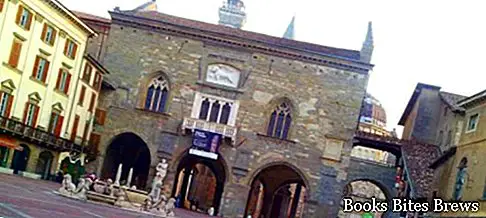What to see in Bergamo, itinerary including the main monuments and places of interest including the Basilica of Santa Maria Maggiore, Piazza Vecchia, the Duomo, the Viscontea Citadel and the Castle of San Vigilio.
Tourist information
Bergamo is a city in Lombardy that is located between the Orobie Alps and the Po Valley, formed by a high part arranged on the hills, surrounded by walls and older, known as Bergamo high, and by the extension of the inhabited area outside the walls, up to the plain, where the modern city, called lower Bergamo, is located.
Bergamo is known as the city of a thousand, because many Bergamo people participated in the famous Garibaldi expedition, it is also the birthplace of the famous composer Gaetano Donizetti, to whom the Municipal Theater, a Museum, the Music Library and the Conservatory are dedicated.
The upper city is located on the site where the Roman and later medieval city stood, fortified with walls of a smaller size than the current ones, dating back to the second half of the sixteenth century and built by the Republic of Venice for defensive purposes, demolishing, among the other, numerous religious and civil buildings in upper Bergamo.
The fortification extends over six km in length with sixteen bulwarks and four monumental gates dedicated to Sant’Alessandro, San Giacomo, Sant’Agostino and San Lorenzo, the latter also known as Porta Garibaldi.
A walk on the walls offers the opportunity to admire the ancient beauties of the city and to appreciate the suggestive panoramic views from above.
Piazza Vecchia is the heart of the upper city, where the eighteenth-century Contarini fountain is located and where the Palazzo della Ragione, Palazzo Nuovo, home of the Angelo Mai Civic Library, the Civic Tower and the Palazzo del Podestà overlook.
Before Piazza Vecchia took on its current size, at the end of the fifteenth century, the fulcrum of the city was the adjacent Piazza Duomo, where there is the Cathedral dedicated to Sant'Alessandro Martire, the Baptistery, the splendid Basilica of Santa Maria Maggiore, which houses the funeral monument of Gaetano Donizetti, and the Renaissance chapel of the Colleoni.
What see
To remember the domination of the Visconti family in Bergamo, which lasted from 1332 to 1428, the Cittadella Viscontea remained, that is what remains of the ancient structure dating back to the second half of the fourteenth century, now home to the Civic Archaeological Museum and the Enrico Museum of Natural Sciences Caffi.
Near the Citadel there is the church of San Lorenzo, under the former sacristy of the church there is instead the Lantro fountain, a large stone cistern used for the collection of water intended for domestic and civil use before the construction of the new aqueduct , which together with the Cannoniera di San Michele and the Cannoniera di San Giovanni, which were rooms used for the armed defense of the city at the time of the Serenissima Republic, forms a very interesting itinerary of underground Bergamo.
Located at the main city crossroads, the medieval tower of Gombito rises to 52 meters high, which takes its name from the Latin compitum, which means crossroads, which has become gombito in dialect.
Recommended readings- Lombardy: Sunday day trips
- Varese (Lombardy): what to see
- Valcamonica (Lombardy): what to see and rock carvings
- Pavia (Lombardy): what to see
- Lake Iseo (Lombardy): what to see in 1 day
From the top of the tower you can enjoy a magnificent panorama of the lower city.
Another beautiful view, which ranges from the city, to the plain and to the mountains, is possible to have it from the belvedere terrace of the Casa dei Bombardieri, which houses the nineteenth-century section of the historical museum of the city, in the Rocca complex, a military fortification dating back to the first mid-fourteenth century, remodeled and restored over time, especially during the Venetian domination.
Above the upper city are the ruins of the Castle of San Vigilio, whose origins date back to the ninth century.
The structure, now used as a public park, was remodeled by the Visconti, from the Republic of Venice and joined to the fort of San Marco through a secret passage.
In the city there are two funiculars, one of which connects the Lower Town with the Upper Town, while the other covers the route from the Upper Town to San Vigilio.




